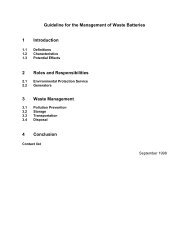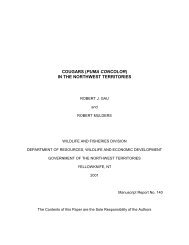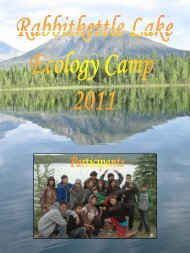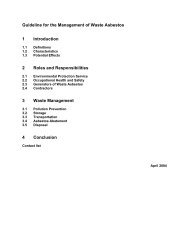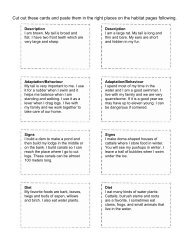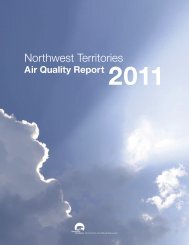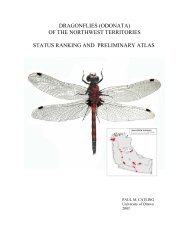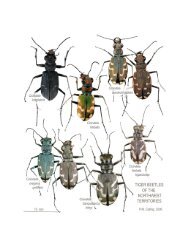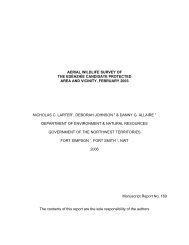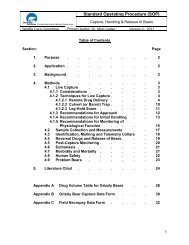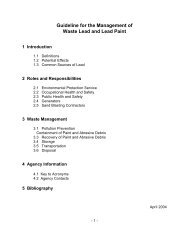Bats of the Northwest Territories
Bats of the Northwest Territories
Bats of the Northwest Territories
- No tags were found...
Create successful ePaper yourself
Turn your PDF publications into a flip-book with our unique Google optimized e-Paper software.
Little Brown MyotisMyotis lucifugusThe little brown myotis is <strong>the</strong> most common batin <strong>the</strong> NWT. It is known to hibernate here. Thisbat <strong>of</strong>ten lives in colonies in buildings but alsoroosts in trees and rock crevices.Wingspan: 22 to 27 cmWeight: 8 to 9 gramsLifespan: Up to 36 yearsRank: May be at riskin <strong>the</strong> NWTStatus:Endangered in CanadaNor<strong>the</strong>rn MyotisMyotis septentrionalisThe nor<strong>the</strong>rn myotis looks similar to a little brownmyotis but its ears are longer. This bat searches forits prey in more cluttered areas like forest edges andovergrown trails. Sometimes it catches insects sittingon twigs or leaves.Wingspan: 23 to 26 cmWeight: 7 to 8 gramsLifespan: About 20 yearsRank: May be at riskin <strong>the</strong> NWTStatus:Endangered in CanadaLong-eared MyotisMyotis evotisThe long-eared myotis is characterized by itsdistinctive long black ears. Its relatively quietecholocation calls are good for sneaking up onprey and moving through cluttered areas.Wingspan: 25 to 29 cmWeight: 7 gramsLifespan: Up to 22 yearsRank: May be at riskin <strong>the</strong> NWTLong-legged MyotisMyotis volansThe long-legged myotis looks very similar to alittle brown myotis and is typically dark brown.It is a bat that lives primarily in coniferousforests.Wingspan: 25 to 27 cmWeight: 8 gramsLifespan: Up to 21 yearsRank: May be at riskin <strong>the</strong> NWTPhoto credit: Michael Durham/BatConservation International (BCI)Photo credit: J. Scott AltenbachPhoto credit: J. Scott AltenbachPhoto credit: Michael Durham/BCIBig Brown BatEptesicus fuscusThe big brown bat is ahigh flier and is easy tospot early in <strong>the</strong> night.This species lives in avariety <strong>of</strong> habitats androosts in trees, rockcrevices and buildings.Wingspan: 32 to 39 cmWeight: 18 to 19 gramsLifespan: 20 yearsRank: Undetermined in<strong>the</strong> NWTSilver-haired BatLasionycteris noctivagansThe silver-haired bat has black wings and dark,silver-tipped hair. It is thought this speciesmigrates south for <strong>the</strong> winter.Wingspan: 27 to 31 cmWeight: 11 gramsLifespan: Up to 12 yearsRank: Undetermined in<strong>the</strong> NWTHoary BatLasiurus cinereusThe hoary bat, named for <strong>the</strong> frosted appearance<strong>of</strong> its fur, roosts among <strong>the</strong> leaves andneedles <strong>of</strong> trees. It is <strong>the</strong> largest bat in Canadaand migrates south for <strong>the</strong> winter.Wingspan: 34 to 41 cmWeight: 28 gramsLifespan: Up to 12 yearsRank: Undetermined in<strong>the</strong> NWTEastern Red BatLasiurus borealisThe eastern red bat’s distinctive orange to redcolouring stands out among o<strong>the</strong>r bats. Thisbat migrates south for <strong>the</strong> winter. Its uniqueultrasound has been recorded in <strong>the</strong> NWTbut <strong>the</strong>re have been nocaptures.Wingspan: 22 to 33 cmWeight: 13 gramsLifespan: About 12 yearsRank: Presence expectedin <strong>the</strong> NWTPhoto credit: Cori LausenPhoto credit: Michael Durham/BCI Photo credit: Michael Durham/BCI Photo credit: Merlin D. Tuttle/BCICover photo credits:Long-eared myotis - Michael Durham/BCILittle brown myotis - Merlin D. Tuttle/BCILittle brown myotis - Michael Durham/BCINote: Maps are based on confirmed observations and willchange as new information becomes available.



